coolant level DODGE CHARGER 2014 7.G Owners Manual
[x] Cancel search | Manufacturer: DODGE, Model Year: 2014, Model line: CHARGER, Model: DODGE CHARGER 2014 7.GPages: 635, PDF Size: 4.72 MB
Page 558 of 635

(antifreeze) solution. The use of lower quality water
will reduce the amount of corrosion protection in the
engine cooling system.
Please note that it is the owner’s responsibility to main-
tain the proper level of protection against freezing ac-
cording to the temperatures occurring in the area where
the vehicle is operated.
NOTE:
• Some vehicles require special tools to add coolant
properly. Failure to fill these systems properly could
lead to severe internal engine damage. If any coolant is
needed to be added to the system please contact your
local authorized dealer.
• Mixing engine coolant (antifreeze) types is not recom-
mended and can result in cooling system damage. If
HOAT and OAT coolant are mixed in an emergency, have a authorized dealer drain, flush, and refill with
OAT coolant (conforming to MS-12106) as soon as
possible.
Cooling System Pressure Cap
The cap must be fully tightened to prevent loss of engine
coolant (antifreeze), and to ensure that engine coolant
(antifreeze) will return to the radiator from the coolant
recovery tank.
The cap should be inspected and cleaned if there is any
accumulation of foreign material on the sealing surfaces.
556 MAINTAINING YOUR VEHICLE
Page 559 of 635
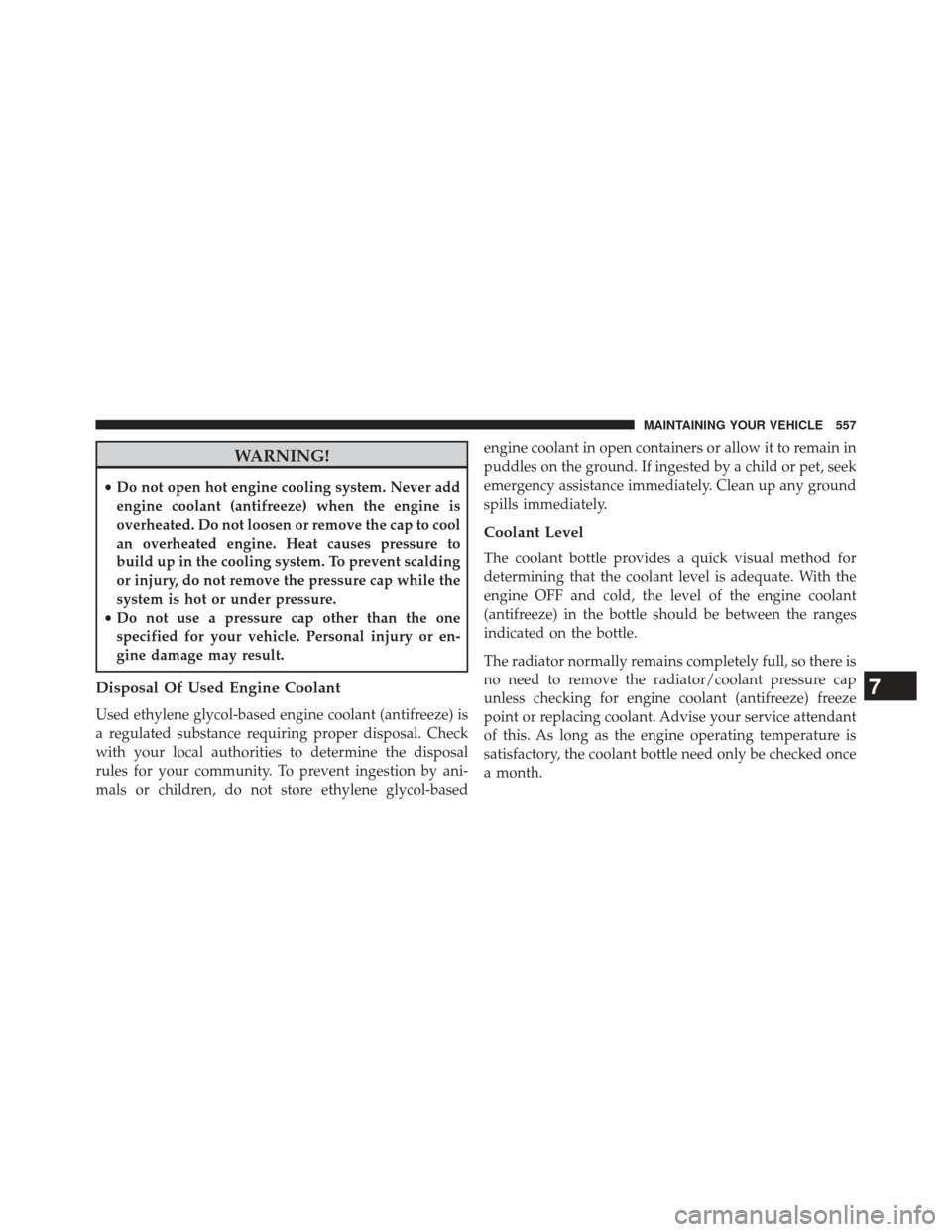
WARNING!
•Do not open hot engine cooling system. Never add
engine coolant (antifreeze) when the engine is
overheated. Do not loosen or remove the cap to cool
an overheated engine. Heat causes pressure to
build up in the cooling system. To prevent scalding
or injury, do not remove the pressure cap while the
system is hot or under pressure.
• Do not use a pressure cap other than the one
specified for your vehicle. Personal injury or en-
gine damage may result.
Disposal Of Used Engine Coolant
Used ethylene glycol-based engine coolant (antifreeze) is
a regulated substance requiring proper disposal. Check
with your local authorities to determine the disposal
rules for your community. To prevent ingestion by ani-
mals or children, do not store ethylene glycol-based engine coolant in open containers or allow it to remain in
puddles on the ground. If ingested by a child or pet, seek
emergency assistance immediately. Clean up any ground
spills immediately.
Coolant Level
The coolant bottle provides a quick visual method for
determining that the coolant level is adequate. With the
engine OFF and cold, the level of the engine coolant
(antifreeze) in the bottle should be between the ranges
indicated on the bottle.
The radiator normally remains completely full, so there is
no need to remove the radiator/coolant pressure cap
unless checking for engine coolant (antifreeze) freeze
point or replacing coolant. Advise your service attendant
of this. As long as the engine operating temperature is
satisfactory, the coolant bottle need only be checked once
a month.
7
MAINTAINING YOUR VEHICLE 557
Page 560 of 635

When additional engine coolant (antifreeze) is needed to
maintain the proper level, only OAT coolant that meets
the requirements of Chrysler Material Standard MS-
12106 should be added to the coolant bottle. Do not
overfill.
Points To Remember
NOTE:When the vehicle is stopped after a few miles/
kilometers of operation, you may observe vapor coming
from the front of the engine compartment. This is nor-
mally a result of moisture from rain, snow, or high
humidity accumulating on the radiator and being vapor-
ized when the thermostat opens, allowing hot engine
coolant (antifreeze) to enter the radiator.
If an examination of your engine compartment shows no
evidence of radiator or hose leaks, the vehicle may be
safely driven. The vapor will soon dissipate.
• Do not overfill the coolant expansion bottle. •
Check the coolant freeze point in the radiator and in
the coolant expansion bottle. If engine coolant (anti-
freeze) needs to be added, the contents of the coolant
expansion bottle must also be protected against freez-
ing.
• If frequent engine coolant (antifreeze) additions are
required, the cooling system should be pressure tested
for leaks.
• Maintain engine coolant (antifreeze) concentration at a
minimum of 50% OAT coolant (conforming to MS-
12106) and distilled water for proper corrosion protec-
tion of your engine which contains aluminum compo-
nents.
• Make sure that the coolant expansion bottle overflow
hoses are not kinked or obstructed.
• Keep the front of the radiator clean. If your vehicle is
equipped with air conditioning, keep the front of the
condenser clean.
558 MAINTAINING YOUR VEHICLE
Page 561 of 635
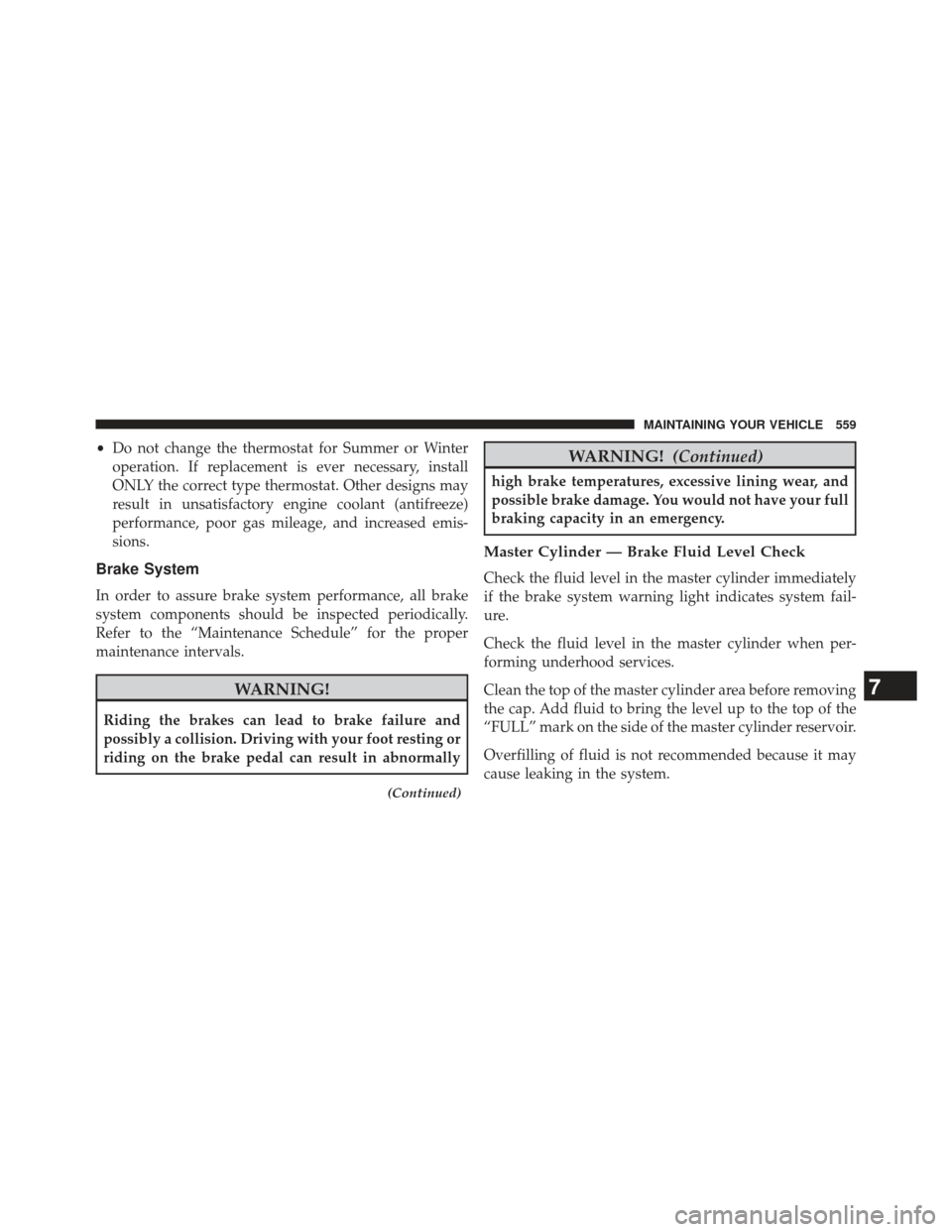
•Do not change the thermostat for Summer or Winter
operation. If replacement is ever necessary, install
ONLY the correct type thermostat. Other designs may
result in unsatisfactory engine coolant (antifreeze)
performance, poor gas mileage, and increased emis-
sions.
Brake System
In order to assure brake system performance, all brake
system components should be inspected periodically.
Refer to the “Maintenance Schedule” for the proper
maintenance intervals.
WARNING!
Riding the brakes can lead to brake failure and
possibly a collision. Driving with your foot resting or
riding on the brake pedal can result in abnormally
(Continued)
WARNING! (Continued)
high brake temperatures, excessive lining wear, and
possible brake damage. You would not have your full
braking capacity in an emergency.
Master Cylinder — Brake Fluid Level Check
Check the fluid level in the master cylinder immediately
if the brake system warning light indicates system fail-
ure.
Check the fluid level in the master cylinder when per-
forming underhood services.
Clean the top of the master cylinder area before removing
the cap. Add fluid to bring the level up to the top of the
“FULL” mark on the side of the master cylinder reservoir.
Overfilling of fluid is not recommended because it may
cause leaking in the system.
7
MAINTAINING YOUR VEHICLE 559
Page 590 of 635
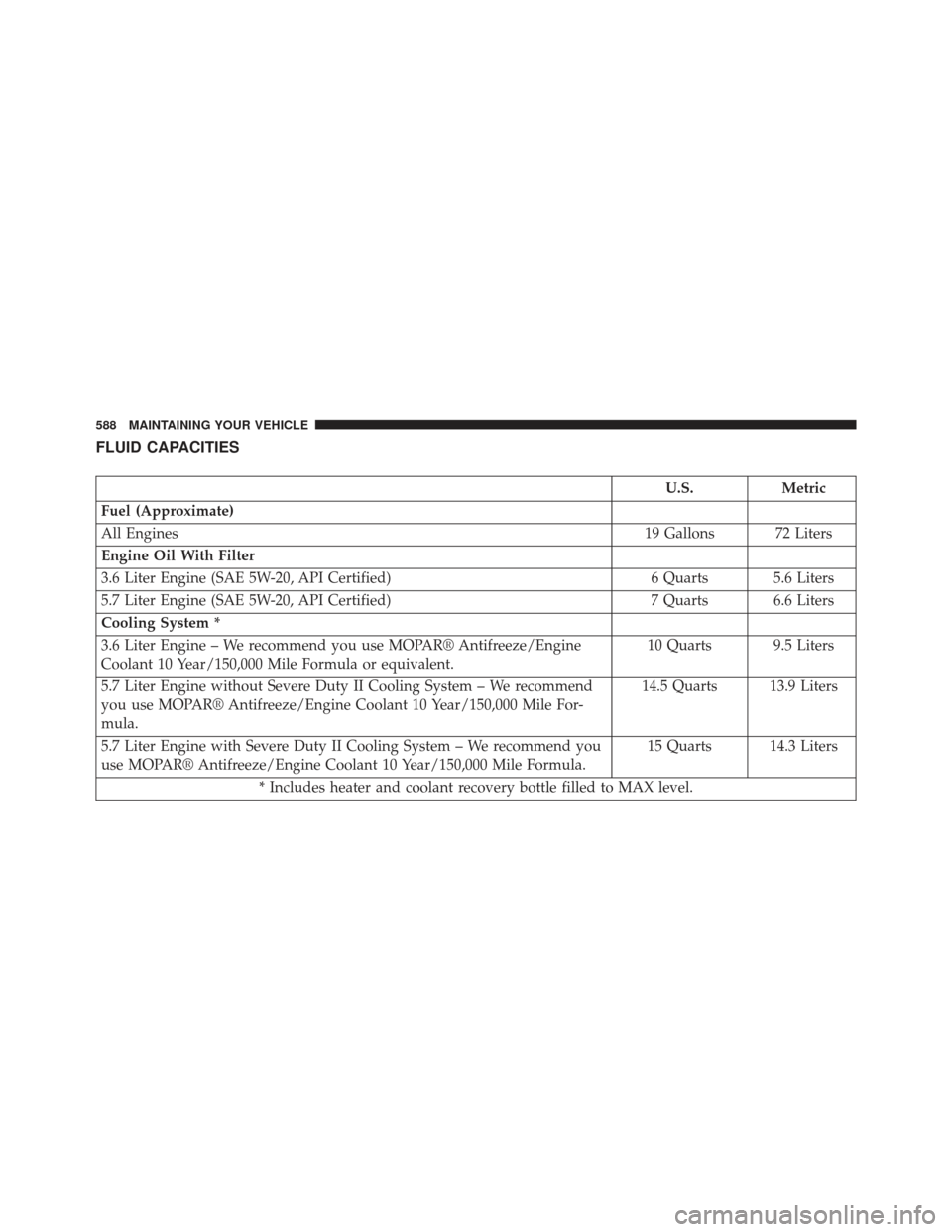
FLUID CAPACITIES
U.S.Metric
Fuel (Approximate)
All Engines 19 Gallons 72 Liters
Engine Oil With Filter
3.6 Liter Engine (SAE 5W-20, API Certified) 6 Quarts 5.6 Liters
5.7 Liter Engine (SAE 5W-20, API Certified) 7 Quarts 6.6 Liters
Cooling System *
3.6 Liter Engine – We recommend you use MOPAR® Antifreeze/Engine
Coolant 10 Year/150,000 Mile Formula or equivalent. 10 Quarts 9.5 Liters
5.7 Liter Engine without Severe Duty II Cooling System – We recommend
you use MOPAR® Antifreeze/Engine Coolant 10 Year/150,000 Mile For-
mula. 14.5 Quarts 13.9 Liters
5.7 Liter Engine with Severe Duty II Cooling System – We recommend you
use MOPAR® Antifreeze/Engine Coolant 10 Year/150,000 Mile Formula. 15 Quarts 14.3 Liters
* Includes heater and coolant recovery bottle filled to MAX level.
588 MAINTAINING YOUR VEHICLE
Page 595 of 635
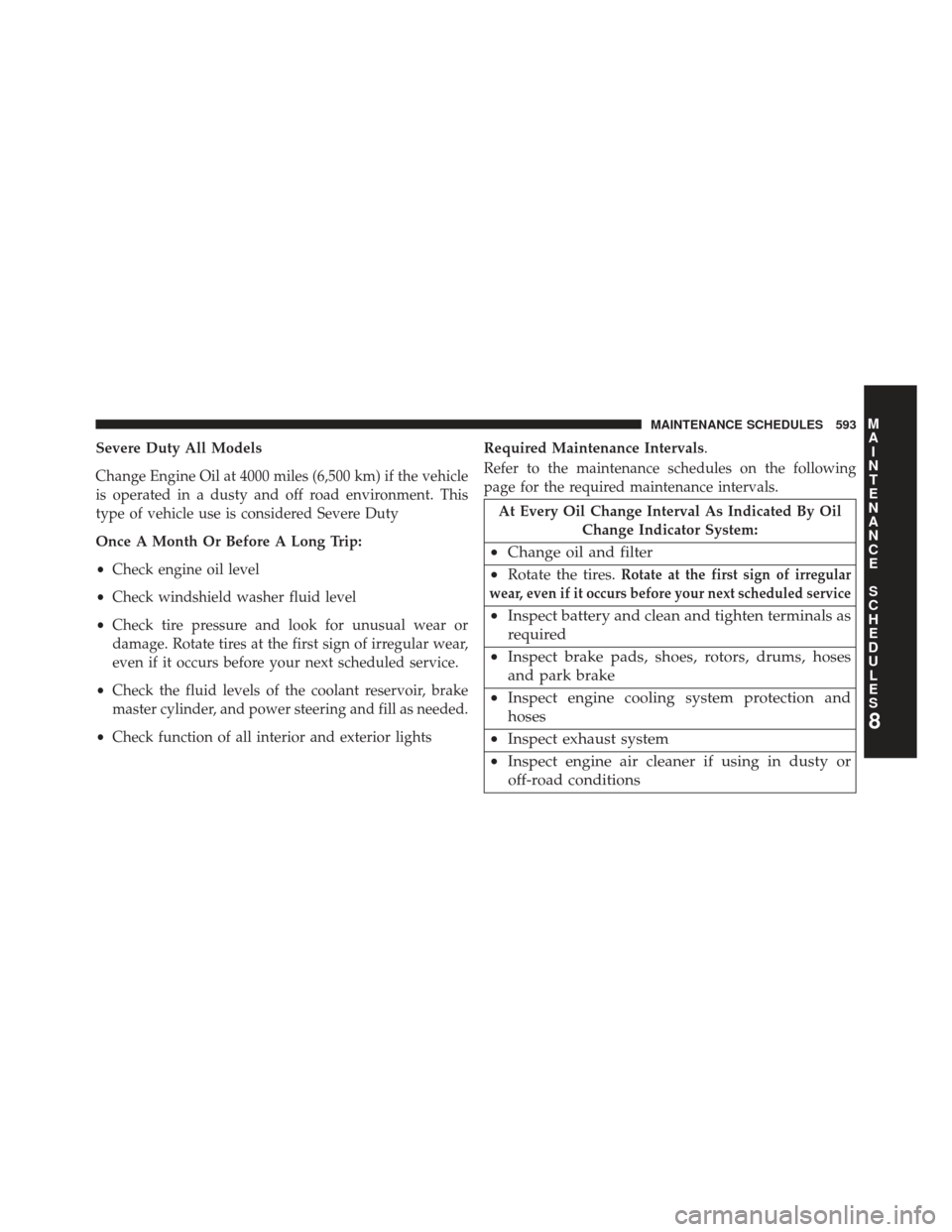
Severe Duty All Models
Change Engine Oil at 4000 miles (6,500 km) if the vehicle
is operated in a dusty and off road environment. This
type of vehicle use is considered Severe Duty
Once A Month Or Before A Long Trip:
•Check engine oil level
• Check windshield washer fluid level
• Check tire pressure and look for unusual wear or
damage. Rotate tires at the first sign of irregular wear,
even if it occurs before your next scheduled service.
• Check the fluid levels of the coolant reservoir, brake
master cylinder, and power steering and fill as needed.
• Check function of all interior and exterior lights Required Maintenance Intervals.
Refer to the maintenance schedules on the following
page for the required maintenance intervals.
At Every Oil Change Interval As Indicated By Oil
Change Indicator System:
•Change oil and filter
•
Rotate the tires.Rotate at the first sign of irregular
wear, even if it occurs before your next scheduled service
• Inspect battery and clean and tighten terminals as
required
• Inspect brake pads, shoes, rotors, drums, hoses
and park brake
• Inspect engine cooling system protection and
hoses
• Inspect exhaust system
• Inspect engine air cleaner if using in dusty or
off-road conditions
8
M
A I
N T
E
N
A
N
C E
S
C
H E
D
U L
E
SMAINTENANCE SCHEDULES 593
Page 615 of 635

CleaningWheels .............................. .567
Climate Control ......................... .374
Coin Holder ............................ .303
Cold Weather Operation ....................395
Compact Disc (CD) Maintenance ..............373
Compact Spare Tire ....................... .458
Computer, Trip/Travel ..................... .337
Connector UCI................................ .369
Universal Consumer Interface (UCI) ..........369
Conserving Fuel ......................... .335
Console, Floor .......................... .303
Contract, Service ......................... .603
Coolant Pressure Cap (Radiator Cap) ...........556
Cooling System .......................... .552
Adding Coolant (Antifreeze) ...............555
Coolant Capacity ...................... .588
Coolant Level ......................... .552Disposal of Used Coolant
.................557
Drain, Flush, and Refill ...................553
Inspection ........................... .557
Points to Remember .....................558
Pressure Cap ......................... .556
Radiator Cap ......................... .556
Selection of Coolant (Antifreeze) .............554
Corrosion Protection ...................... .564
Cruise Control (Speed Control) ................241
Cupholders ............................ .300
Customer Assistance ...................... .601
Customer Programmable Features .............339
Data Recorder, Event .......................72
Daytime Brightness, Interior Lights .............227
Daytime Running Lights ....................220
Dealer Service ........................... .537
Deck Lid, Emergency Release .................44
Deck Lid, Power Release .....................
4210
INDEX 613
Page 617 of 635
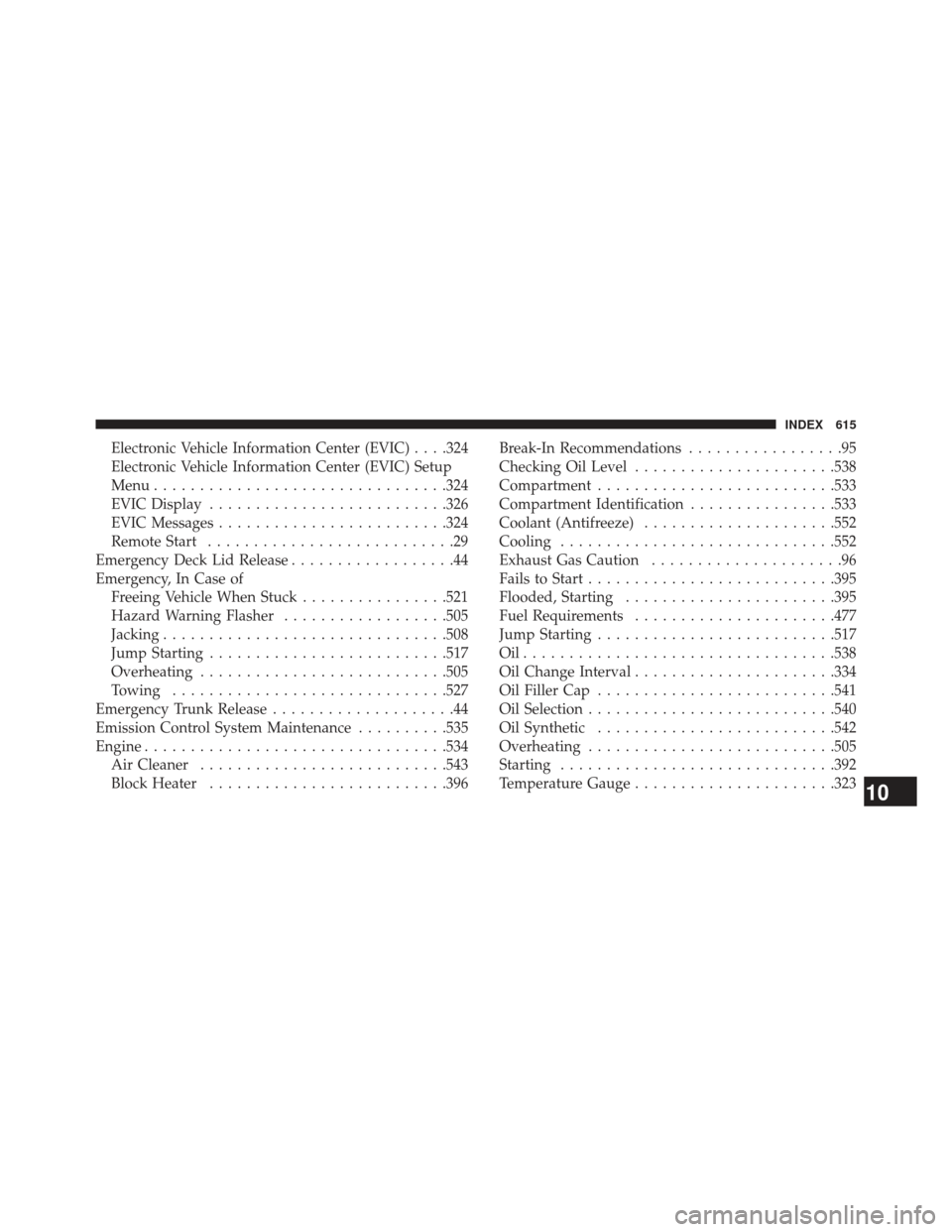
Electronic Vehicle Information Center (EVIC) . . . .324
Electronic Vehicle Information Center (EVIC) Setup
Menu............................... .324
EVIC Display ......................... .326
EVIC Messages ........................ .324
Remote Start ...........................29
Emergency Deck Lid Release ..................44
Emergency, In Case of Freeing Vehicle When Stuck ................521
Hazard Warning Flasher ..................505
Jacking .............................. .508
Jump Starting ......................... .517
Overheating .......................... .505
Towing ............................. .527
Emergency Trunk Release ....................44
Emission Control System Maintenance ..........535
Engine ................................ .534
Air Cleaner .......................... .543
Block Heater ......................... .396Break-In Recommendations
.................95
Checking Oil Level ..................... .538
Compartment ......................... .533
Compartment Identification ................533
Coolant (Antifreeze) .....................552
Cooling ............................. .552
Exhaust Gas Caution .....................96
Fails to Start .......................... .395
Flooded, Starting ...................... .395
Fuel Requirements ..................... .477
Jump Starting ......................... .517
Oil................................. .538
Oil Change Interval ..................... .334
Oil Filler Cap ......................... .541
Oil Selection .......................... .540
Oil Synthetic ......................... .542
Overheating .......................... .505
Starting ............................. .392
Temperature Gauge ..................... .323
10
INDEX 615